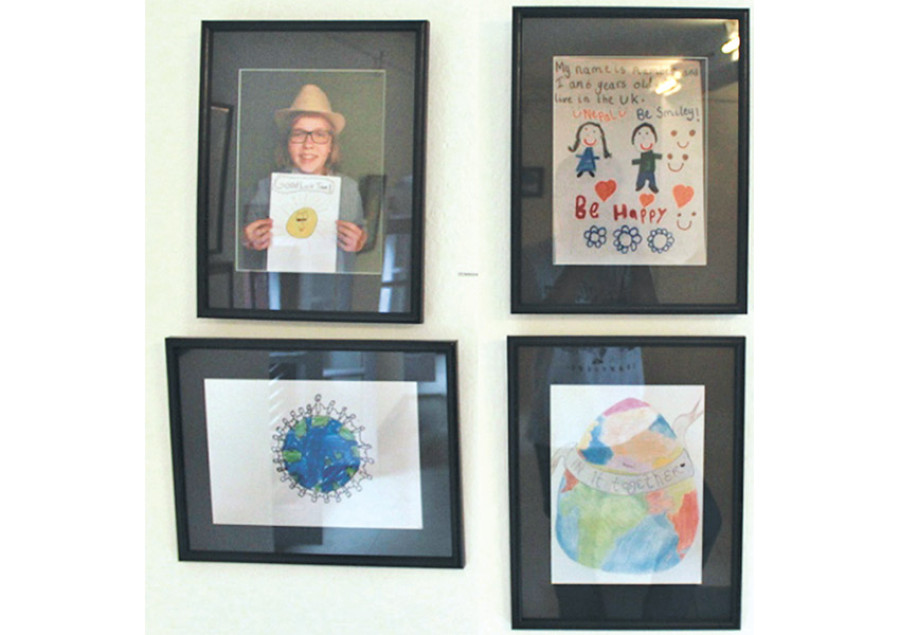Miscellaneous
A homage to Nepal
British muralist Martin Travers was trekking along the Langtang route when the April 25 earthquake struck. The artist, who had just started his residency at KCAC’s Patan Museum studio, had set off to trek after the completion
Nhooja Tuladhar
British muralist Martin Travers was trekking along the Langtang route when the April 25 earthquake struck. The artist, who had just started his residency at KCAC’s Patan Museum studio, had set off to trek after the completion of a collaborative mural project—in which many Nepali street artists had participated—on the wall of the British Embassy in Lainchaur. In his blog, Travers posted a photo story of his perilous journey from Nagthali—over terrain hit hard by landslides—back to Kathmandu.
Travers’ experience of the quake and his interaction with the people in the aftermath of the disaster gave shape to Of Struggles and Dreams: A Homage to the People of Nepal—a painting exhibition currently underway at the Siddhartha Art Gallery in Babermahal.
After reaching the Capital, Travers started conducting art workshops for the earthquake-affected children in various schools and relief camps. Some selected works done by children he taught are exhibited alongside his 12 acrylic portraits. The artist also got in contact with a few schools in England, Ireland, the Netherlands, Australia and the US with the aim to raise awareness regarding the struggle of the children in Nepal, post the disaster. Pictures, letters and drawings by children from these countries are also on display alongside the artworks of Nepali children on the first floor of the gallery.
It is interesting to see how Travers’ show puts together three different perspectives.
First, there are the drawings by the Nepali children—almost all of the earthquake, and almost all dealing with death. Two drawings hang in parallel: Dharahara in the process of stumbling down and a bleeding hand of a person who is buried under debris. Both very graphic, these drawings are unfiltered accounts by children who witnessed the calamity first-hand.
Another perspective is of the children from other countries, who—through their photographs, drawings and letters—have shown solidarity towards the people of Nepal, in a time of crisis. The mood is not as dark as in them. These exude hope—it is easier to be hopeful when it is just something you have seen on television. A child from Berkeley, California, writes: “With great tragedy, comes greater love.”
Travers’ is the third perspective, where he chooses to be the spectator who documents the sorrow of Nepal as well as find hope in the faces of the people that he paints.
The woman in the painting 25.12.2015 stares back at you. Her eyes dewy and her face wrinkled with age. Vermilion stains her forehead. And her eyes reflect (literally) the state the earthquake has left her country in.
Not all of Travers’ works talk of sorry, though. In Untitled 2, a little girl is seen hanging upside down on a makeshift swing with a smile on her face. And in Dhyanastha, an 85x60 cm acrylic-on-canvas, you see a little girl—her pigtails tied with white ribbon—busy painting. In the photorealistic work, Travers has chosen to, primarily, make use of warmer hues.
The rendering of the light and tones are soft and there are no hard edges, which makes the work seem like a soft focus photograph.
And because photorealistic painting is a well-established style these days in Kathmandu—as the works of artists like Hit Man Gurung, Narayan Bohaju clearly attest to—it will be difficult for Travers’ works to draw the Nepali viewers’ eye for a very long time. His portfolio boasts similar works, which work because they are mostly large-scale murals, but putting up paintings in a modestly sized gallery is a different case.
The one—among the 12 paintings—that stands out the most is the diptych titled The Divinity. Done in collaboration with Nepali artist Samundra Man Shrestha, it features portraits of a girl and a man in two different canvases. The girl is seen looking towards the sky; there is something hopeful in her expression. And in the backdrop is the image of the White Tara, painted in the traditional paubha style. The Tara looks almost like it is an image on the wall, and the girl is standing in front of it—a technical trait of Shrestha, which he has made use of in his paintings. The man on the other canvas has his hands up in the air. He is holding, what looks like a kite, preparing to let go and let it fly.
Again, the man here is surrounded by flame motifs of paubha—Shrestha’s handy work.
Travers’ objective, to come here as an artist-in-residency, changed after the disaster. He got involved with the community and has found hope. And through his work he shows us that not all is lost.




 16.24°C Kathmandu
16.24°C Kathmandu










